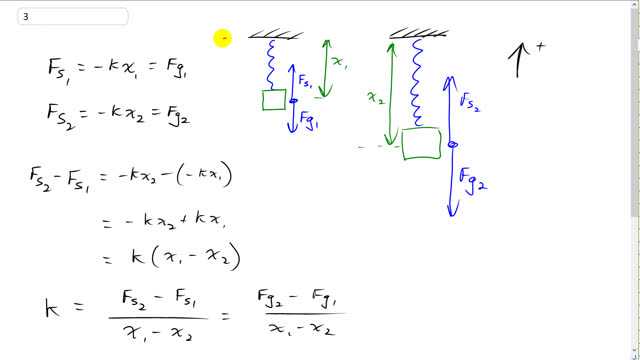
An elastic cord is 61 cm long when a weight of 75 N hangs from it but is 85 cm long when a weight of 210 N hangs from it. What is the “spring” constant of this elastic cord?

In order to watch this solution you need to have a subscription.
This is Giancoli Answers with Mr. Dychko. In the first case with the lighter mass hanging off the spring we have an equilibrium position here at a position x1 below, you know, point zero which will say is up here. And it's gonna have the spring force upwards and gravity down equal to each other and the spring force is negative k times x1 the displacement from equilibrium or from our zero point say. And... Oh sorry, yeah. So, we're told that this x is, is the amount that is stretched from equilibrium. So, I guess, I should draw it. The mathematics works out to be the same but I guess I should draw it so that it's relative to this dotted line here where this dotted line represents equilibrium position. OK. So, yeah we have negative k x1 equals force of gravity. And in the second case we have a greater mass but it's the same mathematics, it's still negative k times the displacement from the equilibrium position x2 in this case, and this equals force of gravity two. So, if we subtract these two equations we can take, subtract the F s2 minus F s1 means we take the right-hand side negative k x2 and subtract that from that negative k x1. So, we have negative k x2 minus negative k x1. And that works out to negative k x2 plus k x1. And you factor out the k and it's x1 minus x2 and then divide both sides by x1 minus x2. Divide this by x1 minus x2. And you get that the spring constant k is force of the spring in the second case minus the force in the spring in the first case divided by the displacement from equilibrium, x1, minus displacement from equilibrium in the second scenario. And these spring forces are equal to the gravity forces in both those cases. And so that's Fg 2 minus Fg 1. And so we have 210 newtons in case 2 minus 75 newtons in case one divided by a displacement x1 of downwards. So, that's negative sign there, we've defined up to be the positive direction. And so that's negative 61 times 10 to the minus 2 meters, I have to convert those centimeters into meters, minus the negative 85 times 10 to the negative 2 meters. And this gives about 560 newtons per meter as the spring constant.